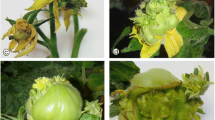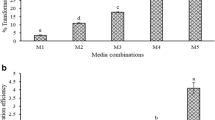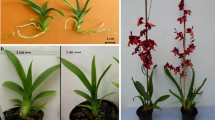Abstract
In this study, the morphological and cytoembryological analyses of the tomato plants transformed with the genes encoding chitin-binding proteins (ac and RS-intron-Shir) from Amaranthus caudatus L. and A. retroflexus L., respectively, as well as the gene amp2 encoding hevein-like antimicrobial peptides from Stellaria media L., have been performed. The transgenic lines were adapted to soil and grown in the greenhouse. The analysis of putative transgenic tomato plants revealed several lines that did not differ phenotypically from the wild type plants and three lines with disruption in differentiation of the inflorescence shoot and the flower, as well as the fruit formation (modified plants of each line were transformed with a single gene as noted before). Abnormalities in the development of the generative organs were maintained for at least six vegetative generations. These transgenic plants were shown to be defective in the mail gametophyte formation, fertilization, and, consequently, led to parthenocarpic fruits. The detailed analysis of growing ovules in the abnormal transgenic plants showed that the replacement tissue was formed and proliferated instead of unfertilized embryo sac. The structure of the replacement tissue differed from both embryonic and endosperm tissue of the normal ovule. The formation of the replacement tissue occurred due to continuing proliferation of the endothelial cells that lost their ability for differentiation. The final step in the development of the replacement tissue was its death, which resulted in the cell lysis. The expression of the genes used was confirmed by RTPCR in all three lines with abnormal phenotype, as well as in several lines that did not phenotypically differ from the untransformed control. This suggests that abnormalities in the organs of the generative sphere in the transgenic plants do not depend on the expression of the foreign genes that were introduced in the tomato genome. Here, we argue that agrobacterial transformation affects, directly or indirectly, expression of genes encoding for transcription factors that can activate a gene cascade responsible for the normal plant development.
Similar content being viewed by others
References
Ampomah-Dwamena, C., Morris, B.A., Sutherland, P., et al., Down-regulation of TM29, a tomato SEPALLATA homolog, causes parthenocarpic fruit development and floral reversion, Plant Physiol., 2002, vol. 130, no. 2, pp. 605–617.
Avivi, Y., Lev-Yadun, S., Morozova, N., et al., Clausa, a tomato mutant with a wide range of phenotypic perturbations, displays a cell type-dependent expression of the homeobox gene LeT6/TKn2, Plant Physiol., 2000, vol. 124, no. 2, pp. 541–551.
Bannikova, V.P., Tsitoembriologiya mezhvidovoi nesovmestimosti u rastenii (Cytoembryology of Interspecific Incompatibility in Plants), Kiev: Naukova dumka, 1975.
Bavrina, T.V., Milyaeva, E.L., Getman, I.A., et al., Manifestation and inheritance of tpd1 phenotype in the tobacco insertion mutant with extended flowering period, Russ. J. Plant Physiol., 2007, vol. 54, no. 5, pp. 646–652.
Bhatia, P. and Ashwath, N., Comparative performance of micropropagated and seed-grown tomato plants, Biol. Plant., 2004, vol. 48, no. 4, pp. 625–628.
Bianchi, A. and Soressi, G.P., Mutanti di pomodoro articialmente indotti suscettibili di utilizzazione nel miglioramento genetic, Sementi Elette XV, 1969, vol. 3, pp. 2–6.
Bourdon, M., Coriton, O., Pirrello, J., et al., In planta quantification of endoreduplication using fluorescent in situ hybridization (fish), J. Plant Sci., 2011, vol. 66, no. 6, pp. 1089–1099.
Cassells, A.C. and Curry, R.F., Oxidative stress and physiological, epigenetic and genetic variability in plant tissue culture: implications for micropropagators and genetic engineers, Plant Cell, Tiss. Organ Cult., 2001, vol. 64, pp. 145–157.
Castle, L.A. and Meinke, D.W., A FUSCA gene of Arabidopsis encodes a novel protein essential for plant development, Plant Cell, 1994, vol. 6, no. 1, pp. 25–41.
Cheniclet, C., Rong, W.Y., Causse, M., et al., Cell expansion and endoreduplication show a large genetic variability in pericarp and contribute strongly to tomato fruit growth, Plant Physiol., 2005, vol. 139, no. 4, pp. 1984–1994.
Chyi, Y.S., Jorgensen, R.A., Goldstein, D., et al., Locations and stability of Agrobacterium-mediated transfer DNA insertions in the Lycopersicon genome, Mol. Gen. Genet., 1986, vol. 204, no. 1, pp. 64–69.
Colombo, M., Masiero, S., Vanzulli, S., et al., AGL23, a type I MADS-box gene that controls female gametophyte and embryo development in Arabidopsis, Plant J., 2008, vol. 54, no. 6, pp. 1037–1048.
Cooper, D.C. and Brink, R.A., Seed collapse following matings between diploid and tetraploid races of Lycopersicon pimpinellifolium, Genetics, 1945, vol. 30, pp. 376–401.
Cristea, T.O., Prisecaru, M., and Clin, M., A comparative study regarding some phenotypic and genetic features in vitro micropropagated and seed-borne tomato (Lycopersicon esculentum Mill.) plants, Sci. Studies and Res. Ser. Biology, vol. 18, pp. 51–54.
Deineko, E.V., Zagorskaya, A.A., and Shumny, V.K., T-DNA-induced mutations in transgenic plants, Russ. J. Genet., 2003, vol. 43, no. 1, pp. 5–17.
Enikeev, A.G., Kopytina, T.V., Semenova, L.A., et al., Agrobacterial transformation as complex biotical factor, J. Stress Physiol. Biochem., 2008, vol. 4, no. 1, pp. 11–19.
Evans, D.A., Sharp, W.R., and Medina-Filho, H.P., Somaclonal and gametoclonal variation, Am. J. Bot., 1984, vol. 71, no. 6, pp. 759–774.
Feldmann, K.A., T-DNA insertion mutagenesis in Arabidopsis: mutation spectrum, Plant J., 1991, vol. 1, no. 1, pp. 71–82.
Gaffe, J., Lemercier, C., Alcaraz, J.P., et al., Identification of three tomato flower and fruit mads-box proteins with a putative histone deacetylase binding domain, Gene, 2011, vol. 471, pp. 19–26.
Gorquet, B., van Heusden, A.W., and Lindhout, P., Parthenocarpic fruit development in tomato, Plant Biol., 2005, vol. 7, no. 2, pp. 131–139.
Gramzow, L. and Theissen, G.A., A hitchhiker’s guide to the MADS world of plants, Genome Biol., 2010, vol. 11, no. 6, pp. 214–224.
Gustafson, F.G., Parthenocarpy induced by pollen extracts, Am. J. Bot., 1937, vol. 24, no. 2, pp. 102–107.
Hirayama, T. and Shinozaki, K., Research on plant abiotic stress responses in the post-genome era: past, present and future, Plant J., 2010, vol. 61, no. 6, pp. 1041–1052.
Jain, S.M., Tissue culture-derived variation in crop improvement, Euphytica, 2001, vol. 118, no. 2, pp. 153–166.
de Jong, M., Mariani, C., and Vriezen, W.H., The role of auxin and gibberellin in tomato fruit set, J. Exp. Bot., 2009, vol. 60, no. 5, pp. 1523–1532.
Kaeppler, S.M., Kaeppler, H.F., and Rhee, Y., Epigenetic aspects of somaclonal variation in plants, Plant Mol. Biol., 2000, vol. 43, pp. 179–188.
Kataoka, K., Uemachi, A., and Yazawa, S., Fruit growth and pseudoembryo development affected by uniconazole, an inhibitor of gibberellin biosynthesis, in pat-2 and auxin-induced parthenocarpic tomato fruits, Sci. Hort., 2003, vol. 98, no. 1, pp. 9–16.
Khaliluev, M.R., Kharchenko, P.N., and Dolgov, S.V., Genetic transformation of tomato (Solanum lycopersicum L.) with genes enconding chitin-binding protective proteins and antimicrobial peptides, Izv. TSKhA, 2010, no. 6, pp. 75–83.
Khaliluev, M.R., Mamonov, A.G., Smirnov, A.N., et al., Expression of genes encoding chitin-binding proteins (PR-4) and hevein-like antimicrobial peptides in transgenic tomato plants enhanced resistanse to Phytophthora infestanse, Russ. Agricult. Sci., 2011, vol. 37, no. 4, pp. 297–302.
Koncz, C., Nemeth, K., Redei, G.P., et al., T-DNA insertional mutagenesis in Arabidopsis, Plant. Mol. Biol., 1992, vol. 20, pp. 963–976.
Lin, Z., Arciga-Reyes, L., Zhong, S., et al., SITPR1, a tomato tetratricopeptide repeat protein, interacts with the ethylene receptors NR and LEETR1, modulating ethylene and auxin responses and development, J. Exp. Bot., 2008, vol. 59, no. 15, pp. 4271–4287.
Maniatis, T., Frisch, E.F., and Sambrook, J., Molecular Cloning: A Laboratory Manual, Cold Spring Harbor: Cold Spring Harbor Lab., 1982.
Mathieu-Rivet, E., Gevaudant, F., Cheniclet, C., et al., The anaphase promoting complex activator CCS52A, a key factor for fruit growth and endoreduplication in tomato, Plant Signaling Behavior, 2010, vol. 5, no. 8, pp. 985–987.
Murashige, T. and Skoog, F., A revised medium for rapid growth and bioassays with tobacco tissue culture, Physiol. Plant., 1962, vol. 15, no. 3, pp. 473–497.
Ohshima, S., Murata, M., Sanamoto, W., et al., Cloning and molecular analysis of Arabidopsis gene Terminal Flower 1, Mol. Gen. Genet., 1997, vol. 254, no. 2, pp. 186–194.
Osman, M.G. and Khalafalla, M.M., Promotion of in vitro shoot formation from shoot tip of tomato (Lycopersicon esculentum Mill. cv. Omdurman) by ethylene inhibitors, Int. J. Curr. Res., 2010, vol. 4, pp. 082–086.
Poddubnaya-Arnol’di, V.A., Tsitoembriologiya pokrytosemennykh rastenii. Osnovy i perspektivy (Cytoembryology of Angiosperms: Foundations and Prospects), Moscow: Nauka, 1976.
Serrani, J.C., Fos, M., Atares, A., et al., Effect of gibberellin and auxin on parthenocarpic fruit growth induction in the cv. Micro-tom of tomato, J. Plant Growth Regulation, 2007, vol. 26, no. 3, pp. 211–221.
Serrani, J.C., Ruiz-Rivero, O., Fos, M., et al., Auxininduced fruit-set in tomato is mediated in part by gibberellins, Plant J., 2008, vol. 56, no. 6, pp. 922–934.
Tinland, B., The integration of T-DNA into plant genomes, Trends Plant Sci., 1996, vol. 1, no. 6, pp. 178–183.
Tzfira, T., Li, J., Lacroix, B., et al., Agrobacterium T-DNA integration: molecules and models, Trends Genet., 2004, vol. 20, no. 8, pp. 375–383.
Veilleux, R.E. and Johnson, A.A.T., Somaclonal variation: molecular analysis, transformation interaction, and utilization, Plant Breed. Rev., 1998, vol. 16, pp. 229–268.
Wang, Y.-H. and Campbell, M.A., Agrobacterium-mediated transformation of tomato elicits unexpected flower phenotypes with similar gene expression profiles, PLoS One, 2008, vol. 3, no. 8, pp. 1–7.
Wickley, B., Elektronnaya mikroskopiya dlya nachinayushchikh (Electron Microscopy for Beginners), Moscow: Mir, 1975.
Wilson, A.K., Latham, J.R., and Steinbrecher, R.A., Transformation-induced mutations in transgenic plants: analysis and biosafety implications, Biotech. Gen. Engineer. Rev., 2006, vol. 23, pp. 209–237.
Author information
Authors and Affiliations
Corresponding author
Additional information
Original Russian Text © M.R. Khaliluev, I.A. Chaban, N.V. Kononenko, E.N. Baranova, S.V. Dolgov, P.N. Kharchenko, V.Yu. Polyakov, 2014, published in Ontogenez, 2014, Vol. 45, No. 1, pp. 28–41.
Rights and permissions
About this article
Cite this article
Khaliluev, M.R., Chaban, I.A., Kononenko, N.V. et al. Abnormal floral meristem development in transgenic tomato plants do not depend on the expression of genes encoding defense-related PR-proteins and antimicrobial peptides. Russ J Dev Biol 45, 22–33 (2014). https://doi.org/10.1134/S1062360414010044
Received:
Accepted:
Published:
Issue Date:
DOI: https://doi.org/10.1134/S1062360414010044




